2004 SUBARU IMPREZA WRX ECU
[x] Cancel search: ECUPage 14 of 491
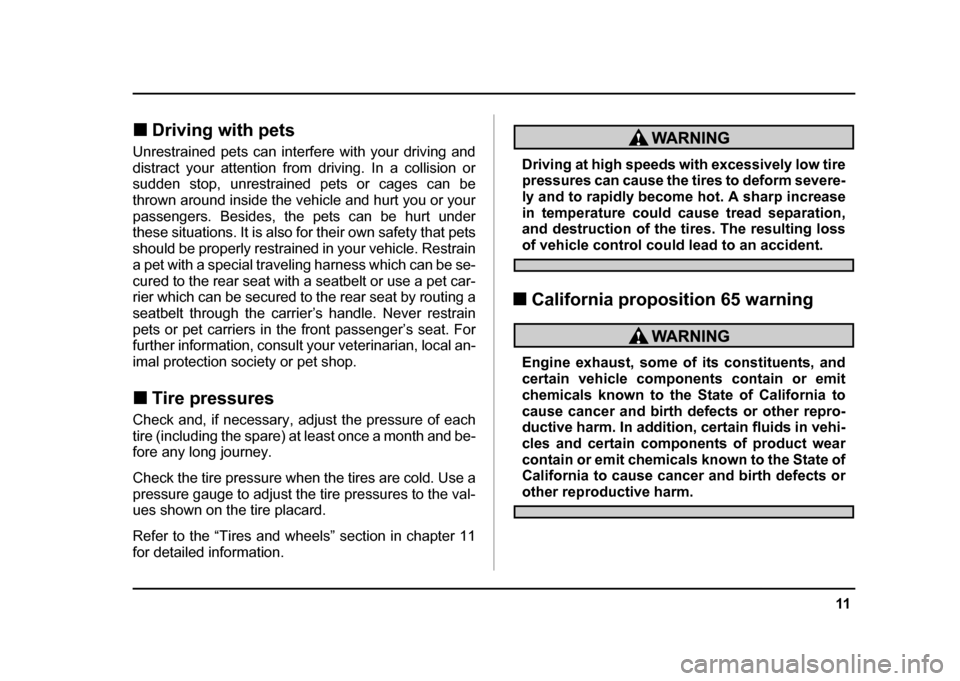
11
–
CONTINUED –
!Driving with pets
Unrestrained pets can interfere with your driving and
distract your attention from driving. In a collision or
sudden stop, unrestrained pets or cages can be
thrown around inside the vehicle and hurt you or your
passengers. Besides, the pets can be hurt under
these situations. It is also for their own safety that pets
should be properly restrained in your vehicle. Restrain
a pet with a special traveling harness which can be se-
cured to the rear seat with a seatbelt or use a pet car-
rier which can be secured to the rear seat by routing a
seatbelt through the carrier’s handle. Never restrain
pets or pet carriers in the front passenger’s seat. For
further information, consult your veterinarian, local an-
imal protection society or pet shop. ! Tire pressures
Check and, if necessary, adjust the pressure of each
tire (including the spare) at least once a month and be-
fore any long journey.
Check the tire pressure when the tires are cold. Use a
pressure gauge to adjust the tire pressures to the val-
ues shown on the tire placard.
Refer to the “Tires and wheels” section in chapter 11
for detailed information.
Driving at high speeds with excessively low tire
pressures can cause the tires to deform severe-
ly and to rapidly become hot. A sharp increase
in temperature could cause tread separation,
and destruction of the tires. The resulting loss
of vehicle control could lead to an accident.
! California proposition 65 warning
Engine exhaust, some of its constituents, and
certain vehicle components contain or emit
chemicals known to the State of California to
cause cancer and birth defects or other repro-
ductive harm. In addition, certain fluids in vehi-
cles and certain components of product wear
contain or emit chemicals known to the State of
California to cause cancer and birth defects or
other reproductive harm.
Page 26 of 491

23
–
CONTINUED –
!Warning and indicator light
Mark Name Page
Seatbelt warning light 3-19
SRS airbag system warning light 3-20
CHECK ENGINE warning light/
Malfunction indicator lamp 3-20
Charge warning light 3-21
Oil pressure warning light 3-21
AT OIL temperature warning light (if equipped) 3-22
or ABS warning light 3-23
or Brake system warning light 3-24
Door open warning light 3-25
Front-wheel drive warning light
(if equipped) 3-25
Turn signal indicator lights 3-26
High beam indicator light 3-26
Security system indicator light (if equipped) 2-14
Intercooler water spray warn-
ing light (if equipped) 3-25
Light indicator light (if equipped) 3-27
Cruise control indicator light (if equipped) 3-26
Cruise control set indicator light 3-26
REV indicator light (if equipped) 3-27
Rear differential oil tempera-
ture warning light (if equipped) 3-22
Electronic driver’s control cen-
ter differential auto indicator (if equipped) 3-26
Mark Name Page
Page 30 of 491
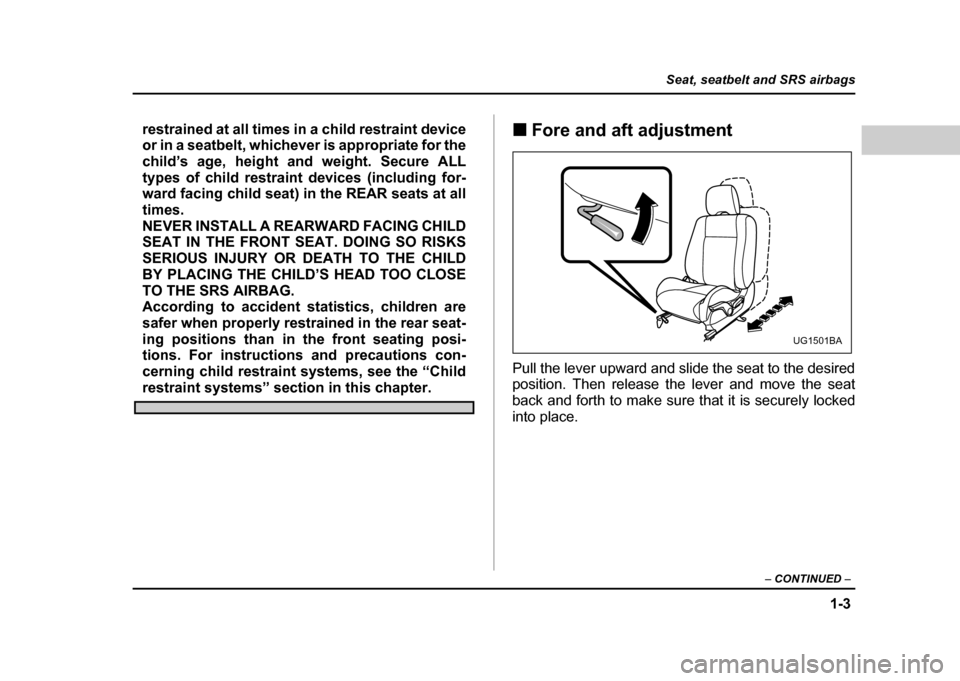
1-3
Seat, seatbelt and SRS airbags
– CONTINUED –
restrained at all times in a child restraint device
or in a seatbelt, whichever is appropriate for the
child’s age, height and weight. Secure ALL
types of child restraint devices (including for-
ward facing child seat) in the REAR seats at all times.
NEVER INSTALL A REARWARD FACING CHILD SEAT IN THE FRONT SEAT. DOING SO RISKS
SERIOUS INJURY OR DEATH TO THE CHILD
BY PLACING THE CHILD’S HEAD TOO CLOSE
TO THE SRS AIRBAG.
According to accident statistics, children are
safer when properly restrained in the rear seat-
ing positions than in the front seating posi-
tions. For instructions and precautions con-
cerning child restraint systems, see the “Child
restraint systems” section in this chapter. !
Fore and aft adjustment
Pull the lever upward and slide the seat to the desired
position. Then release the lever and move the seat
back and forth to make sure that it is securely locked
into place.
UG1501BA
Page 31 of 491
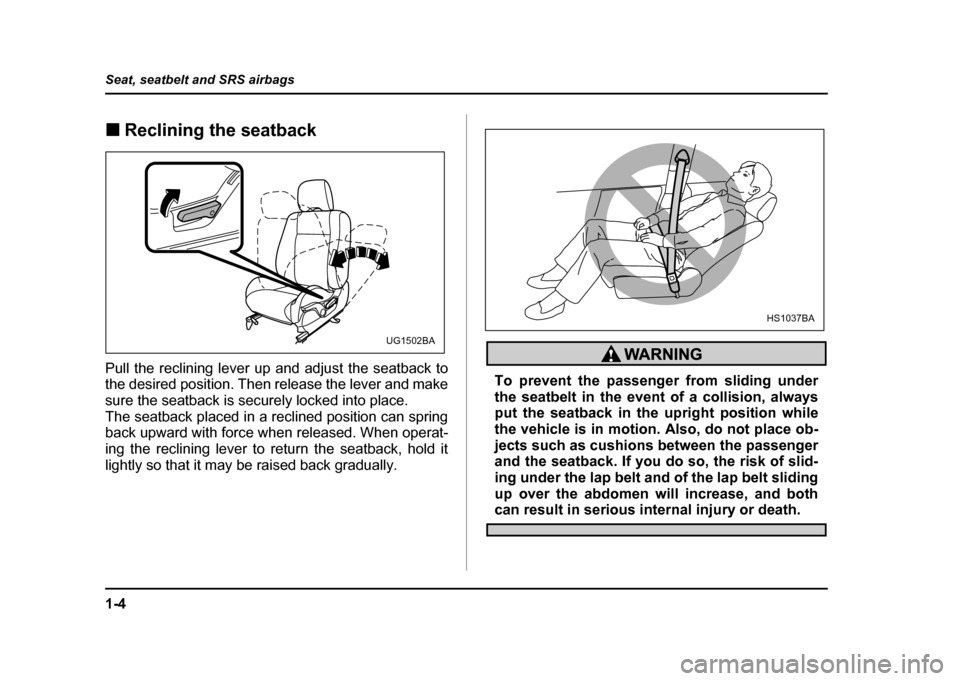
1-4
Seat, seatbelt and SRS airbags
!
Reclining the seatback
Pull the reclining lever up and adjust the seatback to
the desired position. Then release the lever and make
sure the seatback is securely locked into place.
The seatback placed in a reclined position can spring
back upward with force when released. When operat-
ing the reclining lever to return the seatback, hold it
lightly so that it may be raised back gradually.
To prevent the passenger from sliding under
the seatbelt in the event of a collision, always
put the seatback in the upright position while
the vehicle is in motion. Also, do not place ob-
jects such as cushions between the passenger
and the seatback. If you do so, the risk of slid-
ing under the lap belt and of the lap belt sliding
up over the abdomen will increase, and both
can result in serious internal injury or death.
UG1502BA
HS1037BA
Page 37 of 491
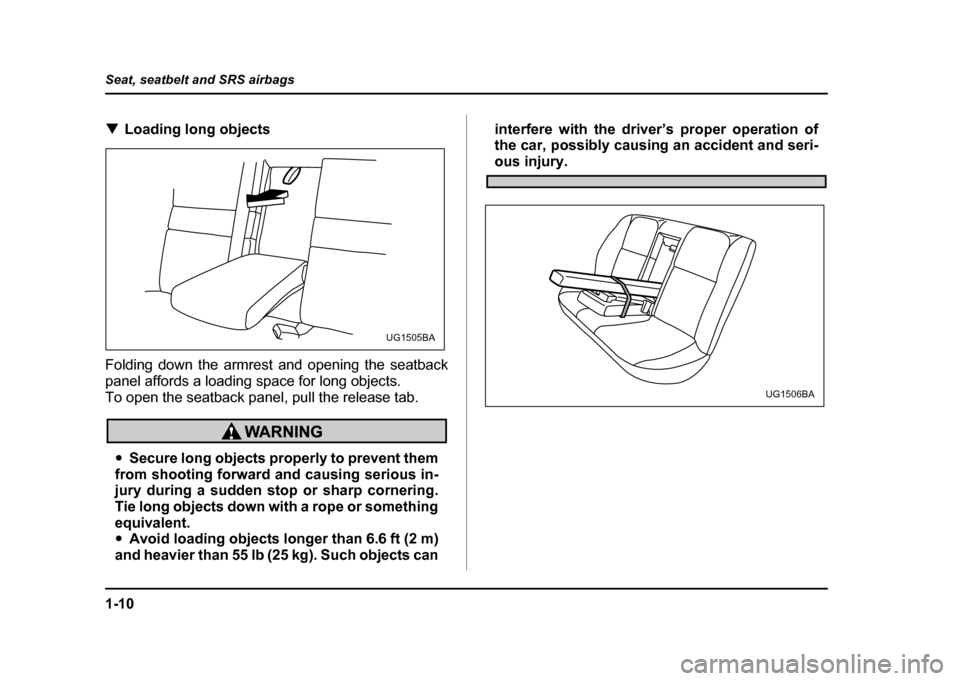
1-10
Seat, seatbelt and SRS airbags
!
Loading long objects
Folding down the armrest and opening the seatback
panel affords a loading space for long objects.
To open the seatback panel, pull the release tab.
" Secure long objects properly to prevent them
from shooting forward and causing serious in-
jury during a sudden stop or sharp cornering.
Tie long objects down with a rope or something
equivalent. " Avoid loading objects longer than 6.6 ft (2 m)
and heavier than 55 lb (25 kg). Such objects can interfere with the driver’s proper operation of
the car, possibly causing an accident and seri-
ous injury.
UG1505BA
UG1506BA
Page 39 of 491
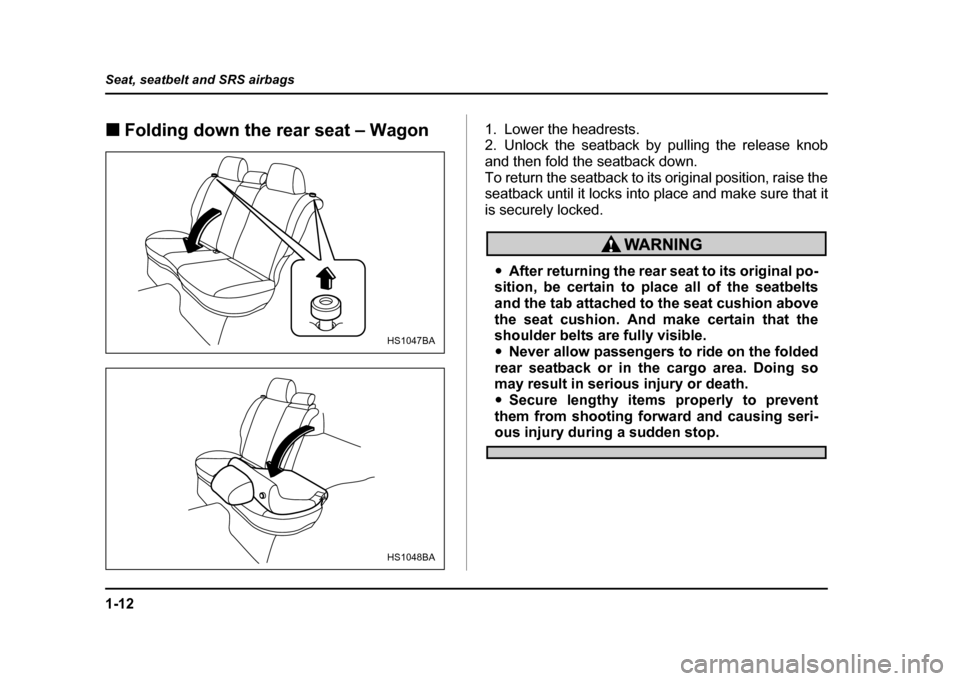
1-12
Seat, seatbelt and SRS airbags
!
Folding down the rear seat – Wagon 1. Lower the headrests.
2. Unlock the seatback by pulling the release knob
and then fold the seatback down.
To return the seatback to its original position, raise the
seatback until it locks into place and make sure that it
is securely locked.
"
After returning the rear seat to its original po-
sition, be certain to place all of the seatbelts and the tab attached to the seat cushion above
the seat cushion. And make certain that the
shoulder belts are fully visible. " Never allow passengers to ride on the folded
rear seatback or in the cargo area. Doing so
may result in serious injury or death. " Secure lengthy items properly to prevent
them from shooting forward and causing seri-
ous injury during a sudden stop.
HS1047BA
HS1048BA
Page 40 of 491
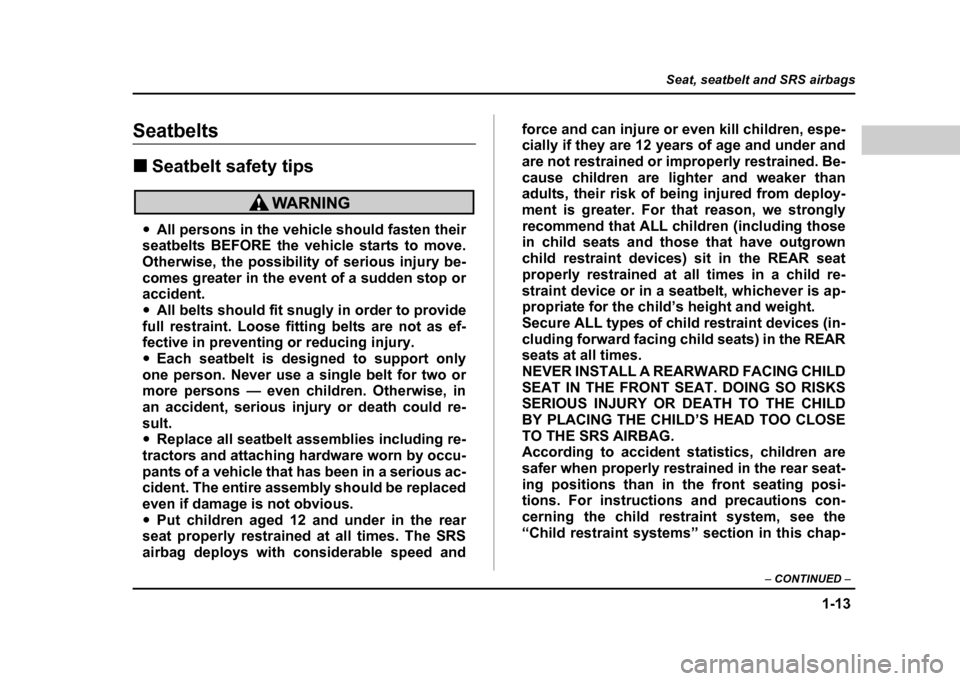
1-13
Seat, seatbelt and SRS airbags
– CONTINUED –
Seatbelts !Seatbelt safety tips
"All persons in the vehicle should fasten their
seatbelts BEFORE the vehicle starts to move.
Otherwise, the possibility of serious injury be-
comes greater in the event of a sudden stop or
accident. " All belts should fit snugly in order to provide
full restraint. Loose fitting belts are not as ef-
fective in preventing or reducing injury. " Each seatbelt is designed to support only
one person. Never use a single belt for two or
more persons — even children. Otherwise, in
an accident, serious injury or death could re-
sult. " Replace all seatbelt assemblies including re-
tractors and attaching hardware worn by occu-
pants of a vehicle that has been in a serious ac-
cident. The entire assembly should be replaced
even if damage is not obvious." Put children aged 12 and under in the rear
seat properly restrained at all times. The SRS
airbag deploys with considerable speed and force and can injure or even kill children, espe-
cially if they are 12 years of age and under and
are not restrained or improperly restrained. Be-
cause children are lighter and weaker than
adults, their risk of being injured from deploy-
ment is greater. For that reason, we strongly
recommend that ALL children (including those
in child seats and those that have outgrown
child restraint devices) sit in the REAR seat
properly restrained at all times in a child re-
straint device or in a seatbelt, whichever is ap-
propriate for the child’s height and weight.
Secure ALL types of child restraint devices (in-
cluding forward facing child seats) in the REAR
seats at all times.
NEVER INSTALL A REARWARD FACING CHILD
SEAT IN THE FRONT SEAT. DOING SO RISKS SERIOUS INJURY OR DEATH TO THE CHILD
BY PLACING THE CHILD’S HEAD TOO CLOSE
TO THE SRS AIRBAG.
According to accident statistics, children are
safer when properly restrained in the rear seat-
ing positions than in the front seating posi-
tions. For instructions and precautions con-
cerning the child restraint system, see the
“Child restraint systems” section in this chap-
Page 41 of 491
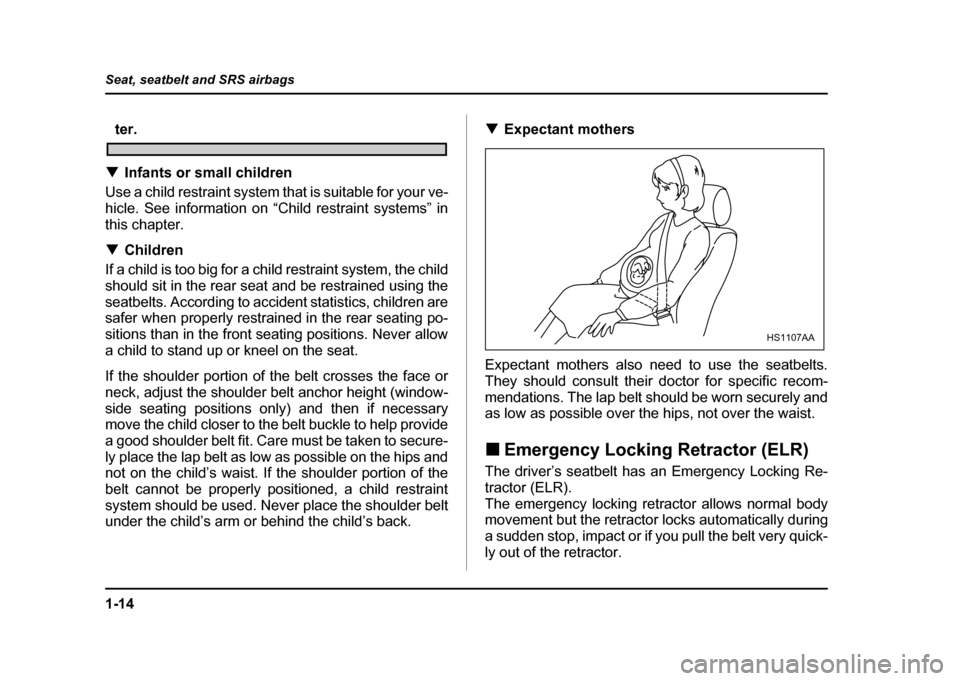
1-14
Seat, seatbelt and SRS airbags
ter.
! Infants or small children
Use a child restraint system that is suitable for your ve-
hicle. See information on “Child restraint systems” in this chapter. ! Children
If a child is too big for a child restraint system, the child
should sit in the rear seat and be restrained using the
seatbelts. According to accident statistics, children are
safer when properly restrained in the rear seating po-
sitions than in the front seating positions. Never allow
a child to stand up or kneel on the seat.
If the shoulder portion of the belt crosses the face or
neck, adjust the shoulder belt anchor height (window-
side seating positions only) and then if necessary
move the child closer to the belt buckle to help provide
a good shoulder belt fit. Care must be taken to secure-
ly place the lap belt as low as possible on the hips and
not on the child’s waist. If the shoulder portion of the
belt cannot be properly positioned, a child restraint
system should be used. Never place the shoulder belt
under the child’s arm or behind the child’s back. !
Expectant mothers
Expectant mothers also need to use the seatbelts.
They should consult their doctor for specific recom-
mendations. The lap belt should be worn securely and
as low as possible over the hips, not over the waist. ! Emergency Locking Retractor (ELR)
The driver’s seatbelt has an Emergency Locking Re-
tractor (ELR).
The emergency locking retractor allows normal body
movement but the retractor locks automatically during
a sudden stop, impact or if you pull the belt very quick-
ly out of the retractor.
HS1107AA